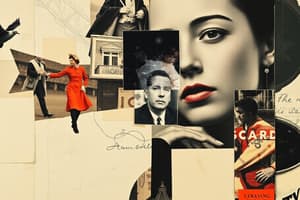Podcast
Questions and Answers
What type of camera movement involves moving upwards or downwards around a vertical line?
What type of camera movement involves moving upwards or downwards around a vertical line?
- Zoom
- Tilt Shot (correct)
- Tracking Shot
- Pan Shot
Which camera movement involves following along next to or behind a moving object or person?
Which camera movement involves following along next to or behind a moving object or person?
- Pan Shot
- Tilt Shot
- Tracking Shot (correct)
- Zoom
What does a 'Zoom' refer to in terms of camera movement?
What does a 'Zoom' refer to in terms of camera movement?
- A camera follows along next to or behind a moving object or person
- A stationary camera moves closer to a subject
- A stationary camera moves further away from a subject
- Both A and B (correct)
What is a convention in the context of media?
What is a convention in the context of media?
Who are the producers in the context of media?
Who are the producers in the context of media?
What is a stakeholder in the context of media?
What is a stakeholder in the context of media?
Who is the audience in the context of media?
Who is the audience in the context of media?
What is a message in the context of media?
What is a message in the context of media?
Which camera movement involves the camera moving horizontally around a vertical line?
Which camera movement involves the camera moving horizontally around a vertical line?
Which of the following is NOT a type of camera movement?
Which of the following is NOT a type of camera movement?
Flashcards are hidden until you start studying
Study Notes
Media Languages
- Media languages consist of codes, conventions, formats, symbols, and narrative structures that convey meaning to an audience.
Codes
- Codes are systems of signs that create meaning when combined.
- There are three types of codes: symbolic, written, and technical codes.
Symbolic Codes
- Represent what lies beneath the surface of what we see, such as objects, setting, body language, clothing, color, etc.
- Use iconic symbols that are easily understood.
Written Codes
- Involve the use of language style and textual layout, including headlines, captions, speech bubbles, and language style.
Technical Codes
- Refer to the ways in which equipment is used to tell a story, including sound, camera angles, types of shots, lighting, camera techniques, framing, depth of field, lighting exposure, and juxtaposition.
Camera Shots
- Extreme Long Shot: shows a large crowd scene or a view of scenery as far as the horizon.
- Long Shot: a distant view of a situation or setting.
- Medium Long Shot: shows a group of people interacting with each other.
- Full Shot: shows a figure's entire body in action or a constellation of characters.
- Medium Close Shot: shows a subject down to their chest or waist.
- Close Up Shot: a full-screen shot of a subject's face, highlighting their expression.
- Extreme Close Up Shot: a detailed shot of a hand, eye, mouth, or object.
Point of View
- Establishing Shot: a long shot taken at the beginning of a scene to indicate the location or setting.
- Point of View Shot: a scene from a character's perspective.
- Over-the-Shoulder Shot: a frontal view of a dialogue partner from the perspective of someone standing behind and slightly to the side.
- Reaction Shot: a short shot of a character's response to an action.
- Insert Shot: a detail shot providing visual information to understand the scene.
- Reverse-Angle Shot: a shot from the opposite perspective.
- Hand-Held Camera Shot: a shot taken with a handheld camera, resulting in less stable footage.
Camera Angles
- Aerial Shot (Bird's Eye Shot): an overhead shot of the ground from the air.
- High-Angle Shot: shows people or objects from above eye level.
- Low-Angle Shot: shows people or objects from below eye level.
- Eye-Level Shot: views a subject from the level of a person's eye.
Camera Movements
- Pan Shot: the camera pans horizontally across the picture.
- Tilt Shot: the camera tilts up or down around a vertical line.
- Tracking Shot: the camera follows a moving object or person.
- Zoom: the camera approaches a subject by zooming in or moves away by zooming out.
Conventions
- Standard or norm that acts as a rule governing behavior.
- Generally established and accepted ways of doing something.
Message and Audience
- Message: information sent from a source to a receiver.
- Audience: the group of consumers for whom the media message was constructed, as well as anyone else exposed to the message.
- Producers: people engaged in creating and putting together media content.
- Stakeholders: libraries, archives, museums, internet, and other relevant information providers.
Studying That Suits You
Use AI to generate personalized quizzes and flashcards to suit your learning preferences.




